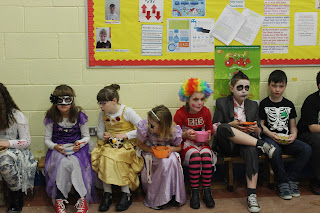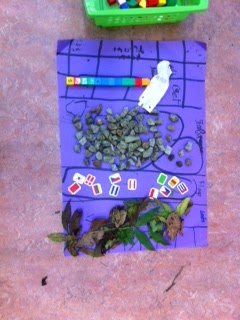Happy Christmas Everyone
Thursday, 17 November 2016
Science Week
Bouncing Balloon
For this experiment you will need:
• an electric hair dryer with circular nozzle
• a balloon
First, blow up the balloon and tie off the end. Hold the balloon out at arm’s length and let go of it. Does it stay there, or drop?
Next, hold the balloon above your head at arm’s length, then blow hard at it as you let go. Can you keep the balloon in the air?
Now hold the hair dryer in one hand, turn it on, and point it up toward the ceiling. Place the balloon in the stream of moving air, and let go. Does the balloon fall to the ground or stay up? Why does this happen?
Experiment further with the hair dryer. If you tilt the nozzle slowly a little to one side, does the balloon stay in the air stream? Can you bring the nozzle back to vertical and make the balloon follow? How far can you tilt the nozzle before the balloon falls? What causes the balloon to stay in the stream of moving air?
For this experiment you will need:
• an electric hair dryer with circular nozzle
• a balloon
First, blow up the balloon and tie off the end. Hold the balloon out at arm’s length and let go of it. Does it stay there, or drop?
Next, hold the balloon above your head at arm’s length, then blow hard at it as you let go. Can you keep the balloon in the air?
Now hold the hair dryer in one hand, turn it on, and point it up toward the ceiling. Place the balloon in the stream of moving air, and let go. Does the balloon fall to the ground or stay up? Why does this happen?
Experiment further with the hair dryer. If you tilt the nozzle slowly a little to one side, does the balloon stay in the air stream? Can you bring the nozzle back to vertical and make the balloon follow? How far can you tilt the nozzle before the balloon falls? What causes the balloon to stay in the stream of moving air?
Build a Circuit
A circuit is a path that electricity flows along. It starts at a power source, like a battery, and flows through a wire to a light bulb or other object and back to other side of the power source. You can build your own circuit and see how it works with this project!
Suction experiment
Mechanically powered flashlight
A mechanically powered flashlight is a flashlight that is
powered by electricity generated by the muscle power of the user, so it does not need replacement of batteries, or recharging from an electrical source.
Tuesday, 8 November 2016
Friday, 21 October 2016
Maths Trail
SCOIL
BHRIDE MATHS TRAIL 2016
Now you're in your team, get ready and best of luck!!!
1. Start at the front door. Walking in a clockwise direction,
(a) count the windows you can see (b) count the doors you can see (c) name 4 right angles, (d) 1 obtuse angle, (e) 1 acute angle, (f) 1 circle, (g) 1 rectangle, (h) 1 square.
2. On your trail, write down the letters you see stuck on the walls and unscramble them to reveal a word as Gaeilge!!
3. Collect various shaped and coloured leaves, pebbles and hidden objects on your trail in your bucket. Make a pictogram with them on your large card at the end.
4. Work out how many children could stand side by side along the white line at the centre of the big yard.
5. Estimate the height of the school from Mrs Coyne/Mrs Clarke's back door.
6. Use your metre stick to measure the length of the big yard.
7. Count the steps at the back of the school. If a snail climbs up 3 steps each day and falls back 1, how long would it take him to reach the top?
8. Work out the area of one of the squares on the alphabet snake. What is the total area of the letters which make up SCOIL BHRIDE?
9. Look at the number plate on the red Audi car. Add up the digits on it. Where can you find 4 more digits on the school building to make the total add up to 35?
10. Add up all of the digits on the glass on the front door.
11. Go to the cubes puzzle board in the gym. Using 12 cubes, make a design which is one third blue and one third green.
12. Use your marker and the bucket of objects you found and create your pictogram on your card in the gym.
CONGRATULATIONS!!
You've completed the 2016 SCOIL BHRIDE maths trail!!
Now you're in your team, get ready and best of luck!!!
1. Start at the front door. Walking in a clockwise direction,
(a) count the windows you can see (b) count the doors you can see (c) name 4 right angles, (d) 1 obtuse angle, (e) 1 acute angle, (f) 1 circle, (g) 1 rectangle, (h) 1 square.
2. On your trail, write down the letters you see stuck on the walls and unscramble them to reveal a word as Gaeilge!!
3. Collect various shaped and coloured leaves, pebbles and hidden objects on your trail in your bucket. Make a pictogram with them on your large card at the end.
4. Work out how many children could stand side by side along the white line at the centre of the big yard.
5. Estimate the height of the school from Mrs Coyne/Mrs Clarke's back door.
6. Use your metre stick to measure the length of the big yard.
7. Count the steps at the back of the school. If a snail climbs up 3 steps each day and falls back 1, how long would it take him to reach the top?
8. Work out the area of one of the squares on the alphabet snake. What is the total area of the letters which make up SCOIL BHRIDE?
9. Look at the number plate on the red Audi car. Add up the digits on it. Where can you find 4 more digits on the school building to make the total add up to 35?
10. Add up all of the digits on the glass on the front door.
11. Go to the cubes puzzle board in the gym. Using 12 cubes, make a design which is one third blue and one third green.
12. Use your marker and the bucket of objects you found and create your pictogram on your card in the gym.
CONGRATULATIONS!!
You've completed the 2016 SCOIL BHRIDE maths trail!!
Tuesday, 4 October 2016
Good Egg!!
Good Egg!!
For this experiment we wanted to make our very own Dead Sea in a glass!
We had to get two eggs, two jars, some warm water and salt. We had to put one egg into a jar of fresh water and one in to a jar of salty water.
Prediction: The egg in the salty water should float and the egg in freshwater should sink..
Result: The egg in the fresh water sank and the egg in the salty water floated!!
The most important thing we learned: The salt makes the water heavy so the egg can sit on top of it. This is just like the Dead Sea where people can actually float on the water!!
Subscribe to:
Comments (Atom)





















































